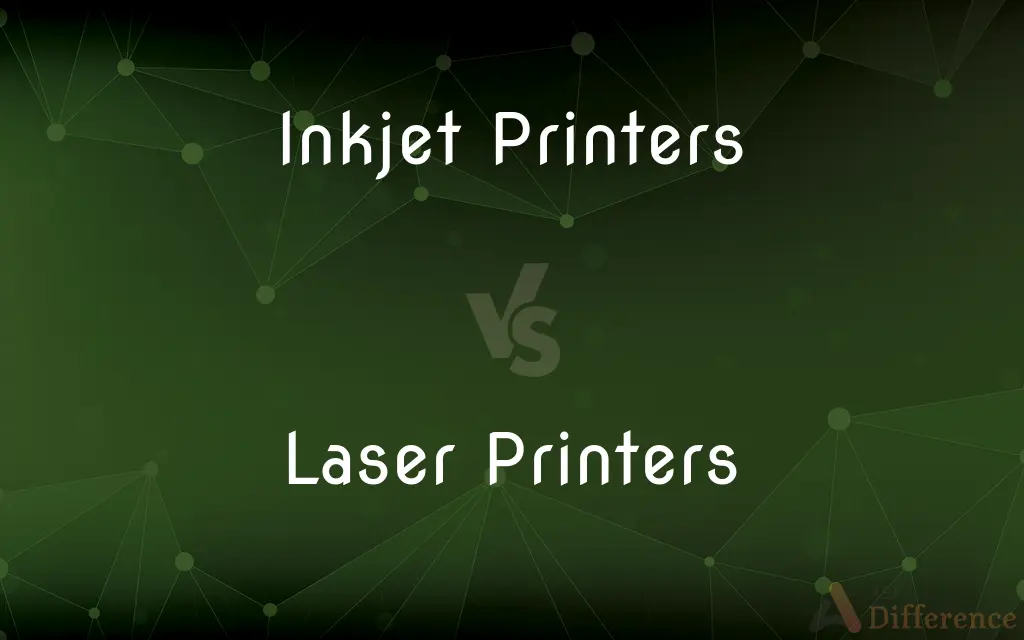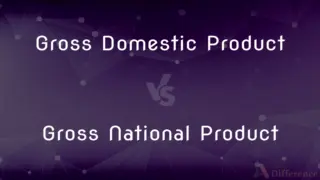Inkjet Printers vs. Laser Printers — What's the Difference?
By Tayyaba Rehman & Fiza Rafique — Published on February 8, 2024
Inkjet printers spray liquid ink through microscopic nozzles, ideal for high-quality color prints, while laser printers use toner and heat to quickly produce sharp text-heavy documents.

Difference Between Inkjet Printers and Laser Printers
Table of Contents
ADVERTISEMENT
Key Differences
Inkjet printers deploy microscopic droplets of liquid ink onto paper, excelling in producing rich and detailed color images, making them preferable for photo printing. Conversely, laser printers use a laser beam to form a pattern on a drum, which attracts powdered toner and transfers it to paper, resulting in precise and high-quality text output, making them ideal for document-heavy tasks.
Inkjet printers generally operate at a slower pace and are designed for lower-volume printing, catering well to home and small office needs. Laser printers, on the other hand, offer higher printing speeds and are built to handle larger volume tasks efficiently, often being the choice for business environments requiring frequent and fast document printing.
Inkjet printers typically have a lower initial purchase cost but can have higher operational costs due to the price of ink cartridges and the need for regular replacement, especially when used frequently. Laser printers, while having a higher initial cost, tend to have a lower cost per page in the long run, with toner cartridges lasting longer than ink cartridges, making them cost-effective for high-volume printing.
Inkjet printers are usually compact and quieter, fitting well in small spaces and causing minimal disturbance. Laser printers are larger due to their complex printing machinery and might generate more noise during operation, which might be a consideration in space-constrained or noise-sensitive environments.
Inkjet printers handle a wide variety of paper types and sizes, accommodating diverse printing needs, including glossy photos and textured stationery. Laser printers, while versatile, are best suited for standard paper sizes and types, excelling in producing crisp text and professional-looking documents.
ADVERTISEMENT
Comparison Chart
Print Technology
Use microscopic nozzles to spray liquid ink.
Use a laser to form a pattern for toner adhesion.
Ideal Usage
Best for high-quality color images and photos.
Best for fast, high-volume text document printing.
Cost Over Time
Lower initial cost, but potentially higher ink cost.
Higher initial cost, but lower cost per page.
Maintenance Frequency
Frequent ink cartridge replacement.
Less frequent toner replacement.
Paper Flexibility
Wide variety of paper types and sizes.
Best with standard paper sizes and types.
Compare with Definitions
Inkjet Printers
Inkjet printers require the maintenance of ink cartridge replacement.
Sara replaced her inkjet printer's cartridges to ensure her portfolio prints were of the highest quality.
Laser Printers
Laser printers offer lower operational costs for high-volume printing.
To reduce the printing costs, the school switched to using a laser printer for its monthly newsletters.
Inkjet Printers
Inkjet printers are known for their ability to produce high-quality color prints.
The photographer relied on her inkjet printer to accurately reproduce the vibrant colors of her landscapes.
Laser Printers
Laser printers typically have a larger footprint and are suitable for office environments.
The new laser printer fit perfectly into the printing room, ready to serve the entire corporate floor.
Inkjet Printers
Inkjet printers are suitable for low-volume, detail-oriented printing tasks.
For his home office, John chose an inkjet printer to print occasional reports with detailed color graphs.
Laser Printers
Laser printers are ideal for high-volume, fast text printing.
The law firm relied on their robust laser printer to produce large quantities of legal documents daily.
Inkjet Printers
Inkjet printers offer versatility in printing on various paper types.
The wedding planner used an inkjet printer to create elegant, textured invitations.
Laser Printers
Laser printers produce prints by fusing toner powder onto paper using heat.
The office's laser printer quickly churned out hundreds of pages for the upcoming meeting.
Inkjet Printers
Inkjet printers create images by precisely spraying ink onto paper.
The graphic designer used an inkjet printer to produce vivid promotional brochures.
Laser Printers
Laser printers are known for their sharp, smudge-free text output.
For her resume, Jane used a laser printer to ensure every letter was crisp and professional.
Common Curiosities
Are laser printers faster than inkjet printers?
Generally, laser printers are faster, especially for text documents, making them suitable for high-volume printing needs.
What are the primary differences between inkjet and laser printers?
Inkjet printers are best for high-quality color images and can print on various paper types, but may have higher ink costs. Laser printers are ideal for fast, high-volume text printing with lower per-page costs.
How environmentally friendly are inkjet and laser printers?
Both have eco-friendly models available, but laser printers may produce ozone and use more energy during operation.
Can laser printers print color documents as well as inkjet printers?
Color laser printers can print color documents, but inkjet printers generally provide better color quality and detail, especially for photos.
Are laser printers suitable for home use?
Yes, there are compact laser printer models designed for home use, especially if you print text-heavy documents frequently.
Can I print photos with a laser printer?
Yes, but inkjet printers are usually better suited for high-quality photo printing.
Do inkjet printers dry out if not used frequently?
Yes, inkjet printers can experience dried ink clogs if not used regularly, requiring maintenance.
How does the print quality compare between inkjet and laser printers?
Inkjet printers provide superior color image quality, while laser printers offer crisp, smudge-free text.
What is the cost difference between inkjet and laser printers?
Inkjet printers usually have a lower initial cost but higher long-term ink costs, whereas laser printers have a higher initial cost but are more economical per page in the long run.
What maintenance is required for inkjet printers?
Inkjet printers require regular ink cartridge replacement and occasional nozzle cleaning to prevent clogs.
Is wireless printing available for both inkjet and laser printers?
Yes, many modern inkjet and laser printers offer wireless connectivity options.
Can inkjet printers use any paper type?
Yes, inkjet printers can print on a wide range of paper types, including glossy and textured papers.
Are laser printers noisier than inkjet printers?
Generally, laser printers are noisier due to their faster printing speed and internal mechanisms.
What is the lifespan of inkjet and laser printers?
Both can last several years with proper maintenance, but laser printers generally have a longer lifespan due to their robust construction.
How do the printing speeds of inkjet and laser printers compare?
Laser printers usually offer faster printing speeds, making them suitable for environments with high-volume printing needs.
Share Your Discovery

Previous Comparison
Data Abstraction vs. Data Hiding
Next Comparison
Gross Domestic Product vs. Gross National ProductAuthor Spotlight
Written by
Tayyaba RehmanTayyaba Rehman is a distinguished writer, currently serving as a primary contributor to askdifference.com. As a researcher in semantics and etymology, Tayyaba's passion for the complexity of languages and their distinctions has found a perfect home on the platform. Tayyaba delves into the intricacies of language, distinguishing between commonly confused words and phrases, thereby providing clarity for readers worldwide.
Co-written by
Fiza RafiqueFiza Rafique is a skilled content writer at AskDifference.com, where she meticulously refines and enhances written pieces. Drawing from her vast editorial expertise, Fiza ensures clarity, accuracy, and precision in every article. Passionate about language, she continually seeks to elevate the quality of content for readers worldwide.













































